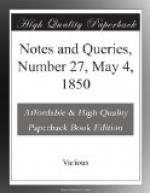I have been induced to trespass on your columns with this extended notice of the difficulty which was never solved by either the Hebrews or Greeks, from understanding your correspondent “T.S.D.” p. 367, to say that “the mode of obviating it would suggest itself at once.” As to the original query,—whence came the invention of the cipher, which was felt to be so valuable as to be entitled to give its name to all the process of arithmetic?—“T.S.D.” has given the querist his best clue in sending him to Mr. Strachey’s Bija Ganita, and to Sir E. Colebrooke’s Algebra of the Hindus, from the Sanscrit of Brahmegupta. Perhaps a few sentences may sufficiently point out where the difficulty lies. In the beginning of the sixth century, the celebrated Boethius described the present system as an invention of the Pythagoreans, meaning, probably, to express some indistinct notion of its coming from the east. The figures in MS. copies of Boethius are the same as our own for 1, 8, and 9; the same, but inverted, for 2 and 5; and are not without vestiges of resemblance in the remaining figures. In the ninth century we come to the Arabian Al Sephadi, and derive some information from him; but his figures have attracted most notice, because though nearly all of them are different from those found in Boethius, they are the same as occur in Planudes, a Greek monk of the fourteenth century, who says of his own units, “These nine characters are Indian,” and adds, “they have a tenth character called [Greek: tziphra], which they express by an 0, and which denotes the absence of any number.” The date of Boethius is obviously too early for the supposition of an Arabic origin; but it is doubted whether the figures are of his time, as the copyists of a work in MS. were wont to use the characters of their own age in letters, and might do so in the case of figures also.
H.W.
* * * * *
ROMAN NUMERALS.
There are several points connected with the subject of numerals that are important in the history of practical arithmetic, to which neither scientific men nor antiquaries have paid much attention. Yet if the principal questions were brought in a definite form before the contributors to the “NOTES AND QUERIES,” I feel quite sure that a not inconsiderable number of them will be able to contribute each his portion to the solution of what may till now be considered as almost a mystery. With your permission, I will propose a few queries relating to the subject,
1. When did the abacus, or the “tabel” referred to in my former letters, cease to be used as calculating instruments?
The last printed work in which the abacal practice was given for the purposes of tuition that I have been able to discover, is a 12mo. edition, by Andrew Mellis, of Dee’s Robert Recorde, 1682.
2. When did the method of recording results in Roman numerals cease to be used in mercantile account-books? Do any ledgers or other account-books, of ancient dates, exist in the archives of the City Companies, or in the office of the City Chamberlain? If there do, these would go far towards settling the question.




